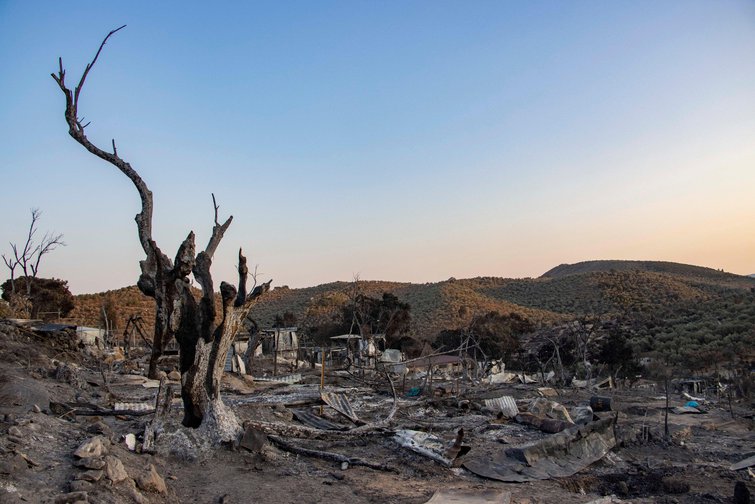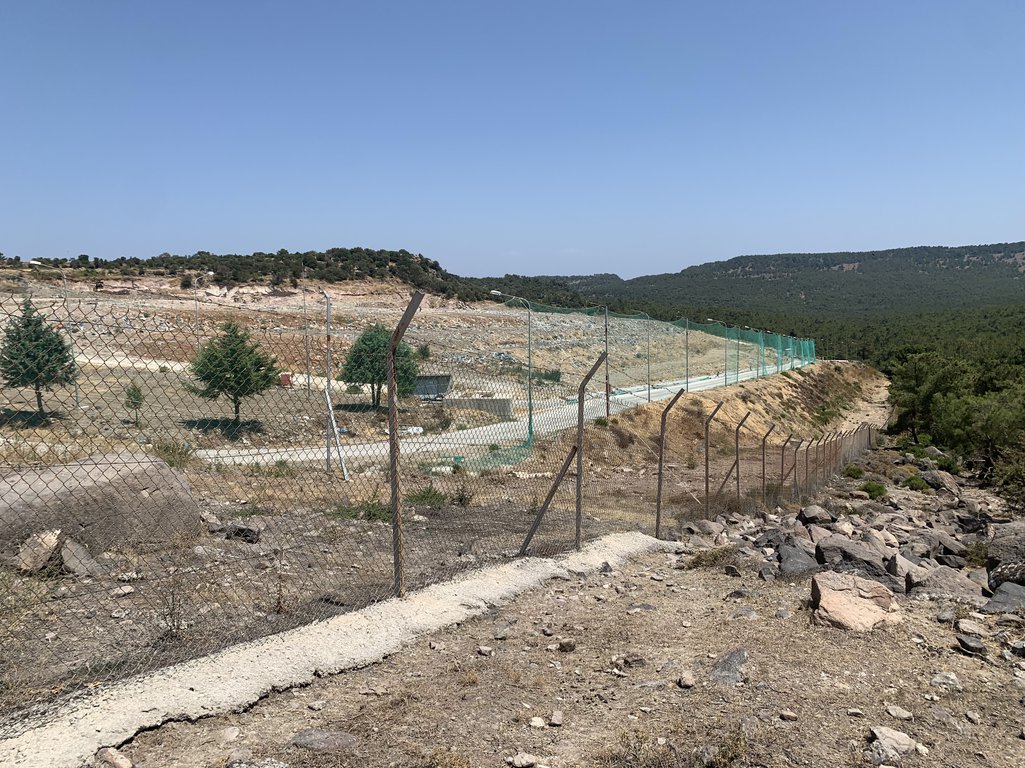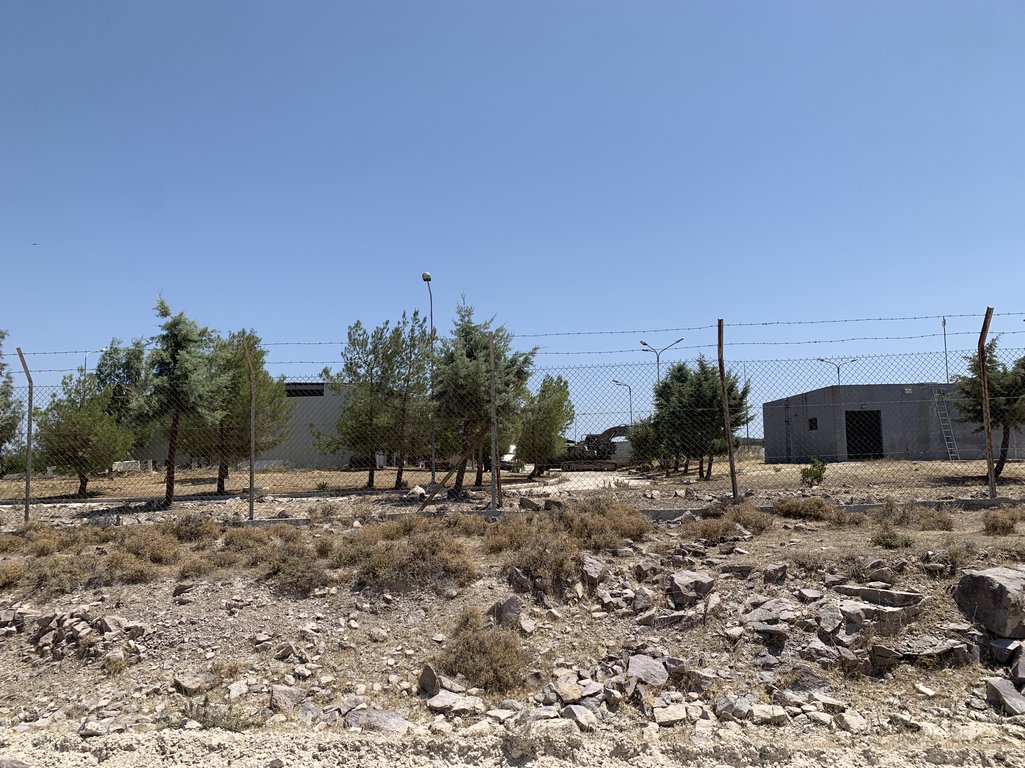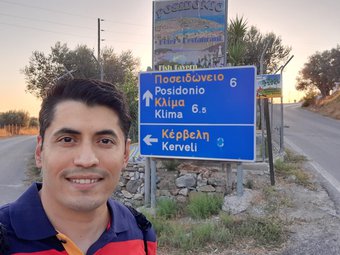DISASTER CAPITALI$M REFUGEE'S
Planned Greek refugee camp is in ‘high-risk’ fire zone next to landfillExperts say the location of Lesbos’s new refugee camp is remote, prone to wildfires and would be ‘nearly impossible’ to evacuate
Sebastian Skov Andersen & Gabriel Geiger
15 February 2022

The aftermath of the fire at the Moria refugee camp in September 2020 |
Nik Oiko/ZUMA Press Inc / Alamy Stock Photo
The unpaved road leading to the site of the future refugee camp on the Greek island of Lesbos is long and winding, snaking through dry forest terrain for roughly ten kilometres. Far from any towns, and adjacent to a domestic landfill site, this remote area, which is at risk of wildfires, projects a far from subtle message: out of sight, out of mind.
The planned refugee camp is one of five new EU-funded, high-security, multi-purpose reception and identification centres (MPRICs), promised as part of the European Union and Greek government’s new pact on migration to replace the current camps on the country’s islands. The agreement was announced in September 2020, just days after the notorious Moria refugee camp on Lesbos burned down.
According to the pact, the new refugee camps must ensure, among other things, the right to “health” and “security” for the asylum seekers living in them. In practice, this has translated into prison-like conditions, with barbed-wire fences and concrete walls surrounding the camps, and 24/7 surveillance.
In November 2020, Greek media, citing government sources, reported that the new camp on Lesbos would be built at Vastria, adjacent to the island’s largest landfill dump, at the far edge of the municipality of Mytilini and inside a large, protected forest. A month later, the European Commission published a ‘memorandum of understanding’ regarding a new “pilot” camp on Lesbos. The objective of the pilot, the commission wrote, was to “channel the necessary support to the Greek authorities for completing and operating, by September 2021, an up-to-standard fully functioning MPRIC on Lesvos with a capacity of 5,000 people”.
However, construction of the Lesbos camp was postponed without explanation – it is now expected to open in September this year – while the new camps on the islands of Chios, Kos, Leros and Samos opened last year.
“A new era is beginning,” claimed Greek migration minister Notis Mitarachi at the opening ceremony for one camp. “We are extricating our islands from the migration problem and its consequences.”
Last week, island residents protested at Vastria, after the construction company charged with building the camp began moving machines to the site overnight. Police reportedly arrested four people for defacing construction equipment and some machinery was even lit on fire. The same day, the governor of the North Aegean region, Costas Moutzouris, announced that he would be appealing to the Council of Europe against the construction of the camp.
Wildfire danger
Humanitarian organisations and forestry and fire experts expressed alarm to openDemocracy at the remote location of the planned Lesbos camp – especially in the wake of Greece’s record heatwave last summer, which forced mass evacuations on the mainland and some islands.
Lesbos residents received emergency warnings via SMS prohibiting them from entering forests because of the wildfire risk, and firefighter trucks were stationed at intervals along mountain roads. With Moria’s destruction by arson still fresh in people’s minds, the potential threat of wildfires to the new camp seemed overwhelming, according to local media.
Natural hazards expert Michalis Diakakis from the University of Athens said the proposed location is a “high-risk zone” for wildfires, due to its low altitude, minimal summer rainfall and dense, highly flammable pine forests.

The planned Vastria refugee camp is several kilometres from the nearest town | Sebastian Skov Andersen
Diakakis, who is also an adviser to the Greek fire service, said that most wildfires on Lesbos happen in the eastern part of the island, where Vastria is located, because of its dense, tall forests – the proposed new camp is on the edge of the largest forest in the Aegean. To safely operate a camp in such a location would require significant measures to both prevent and extinguish wildfires, including keeping firefighting machinery such as fire trucks and bulldozers on site, clearing vegetation both inside and around the camp, and developing clear evacuation plans and routes.
“The majority of fatalities happen in areas where you have a lot of people trying to get away from a place, [making] it difficult to evacuate,” Diakakis said. “Because of the heavy smoke and toxic gases, people tend to inhale huge amounts and then collapse, and then the fire catches them. Most deaths […] like that are in small areas with a few houses, or in small towns near forests.”
The European Commission’s migration department said they were aware of the issue, adding that the Greek authorities were responsible for ensuring the camp’s safety and that the commission had faith in their ability to do so.
The commission said by email: “[The] local forest authority and the fire brigade will be consulted and provide approval at every stage of planning and implementation of the new centre. To combat the risks associated with a fire starting from within the centre, the installation of a fire protection system is foreseen. […] Evacuation plans and safe evacuation routes are a prerequisite for building facilities for accommodation of any kind.”
The Greek ministry of migration and asylum did not respond to multiple emails from openDemocracy asking if any measures were being taken to ensure the safety of camp residents in the event of a wildfire. Last month, according to Greek media, the country’s parliament voted for an amendment to permit approvals for refugee camp structures on the Greek islands and also in Evros on the mainland. Instead of consulting regional services, the ministry wants to oversee and approve studies carried out by its own directorate of technical services.

Diakakis, who is also an adviser to the Greek fire service, said that most wildfires on Lesbos happen in the eastern part of the island, where Vastria is located, because of its dense, tall forests – the proposed new camp is on the edge of the largest forest in the Aegean. To safely operate a camp in such a location would require significant measures to both prevent and extinguish wildfires, including keeping firefighting machinery such as fire trucks and bulldozers on site, clearing vegetation both inside and around the camp, and developing clear evacuation plans and routes.
“The majority of fatalities happen in areas where you have a lot of people trying to get away from a place, [making] it difficult to evacuate,” Diakakis said. “Because of the heavy smoke and toxic gases, people tend to inhale huge amounts and then collapse, and then the fire catches them. Most deaths […] like that are in small areas with a few houses, or in small towns near forests.”
The European Commission’s migration department said they were aware of the issue, adding that the Greek authorities were responsible for ensuring the camp’s safety and that the commission had faith in their ability to do so.
The commission said by email: “[The] local forest authority and the fire brigade will be consulted and provide approval at every stage of planning and implementation of the new centre. To combat the risks associated with a fire starting from within the centre, the installation of a fire protection system is foreseen. […] Evacuation plans and safe evacuation routes are a prerequisite for building facilities for accommodation of any kind.”
The Greek ministry of migration and asylum did not respond to multiple emails from openDemocracy asking if any measures were being taken to ensure the safety of camp residents in the event of a wildfire. Last month, according to Greek media, the country’s parliament voted for an amendment to permit approvals for refugee camp structures on the Greek islands and also in Evros on the mainland. Instead of consulting regional services, the ministry wants to oversee and approve studies carried out by its own directorate of technical services.

Humanitarian organisations and wildfire experts have expressed alarm over the location of the Vastria camp
| Sebastian Skov Andersen
While there is a wide – but currently unpaved – road connecting the camp to a small motorway to the south, only a small dirt road leads in the other direction. “If you don’t have a warning system in place, then it’s optimal to have two ways out. If you do [have a system], you can usually stick with one. So, if you have a fire coming from the south, you migrate to the north; if you have a fire coming from the north, you migrate to the south,” explained Diakakis. The Greek government has not given any indication as to whether they would improve road access to and from the camp.
Fires have also posed a challenge for the Mavrovouni camp on Lesbos, which was erected as a temporary replacement for Moria. There have been multiple reports of fires there; openDemocracy was able to confirm at least one, in December, by speaking to numerous camp residents who witnessed it. No casualties or major injuries have been reported.
Evacuation ‘nearly impossible’
The NGO Lesvos Solidarity criticised the plans for the new camp, noting that Greek environmental regulations from 2016 set a capacity limit of 750 residents per refugee camp. Larger camps need a comprehensive environmental impact assessment in order to gain a permit. In April 2020, before the burning of Moria and the subsequent migration pact, a ministerial decree increased the limit from 750 to 5,000 – significantly increasing the challenge of evacuation from areas such as Vastria.
Among those who have expressed concern about the new camp’s location is forestry expert Babis Petsikos, formerly of the Aegean University’s environmental department on Lesbos. He has also served as an adviser to Greece’s ministry of Environment and the United Nations’ climate change panel (UNFCCC). His former job dealt with the management and preservation of Lesbos’s forests.
Petsikos said it was “extremely possible” that a fire would break out in the area. “The lowland pine forest around the camp is the most flammable forest type in the Mediterranean,” he said. “If a fire breaks out, it will be very difficult – if not impossible – to extinguish before everything burns down. And experience shows that fires often break out in and around refugee camps.”
Petsikos added: “This is extremely dangerous for everyone living around there, and we do not know about the safety of people’s lives as we have not seen any fire protection plan.”
The lowland pine forest around the camp is the most flammable forest-type in the Mediterranean
He also noted that, in summer, the island’s winds typically blow from north to south – the same direction as the road from the camp, which is currently the only evacuation route.
According to Thomas Cova, a wildfire evacuation expert and professor of human geography at the University of Utah, a mass evacuation from the proposed location, even with a viable access road, would be “nearly impossible”. “I don’t think an evacuation is feasible,” Cova said. “If you have a thousand-plus people, you wouldn’t have the vehicles to move them and it’s too far from the coast to use a boat.”
The only viable option, according to Cova, is for camp residents to shelter in place. This would require Greek authorities to clear enough vegetation to create a minimum ten-metre gap between the camp and the forest. Creating a camp large enough to safely fit thousands of residents could be a challenge, however, and the risk of smoke inhalation remains.
Related story
While there is a wide – but currently unpaved – road connecting the camp to a small motorway to the south, only a small dirt road leads in the other direction. “If you don’t have a warning system in place, then it’s optimal to have two ways out. If you do [have a system], you can usually stick with one. So, if you have a fire coming from the south, you migrate to the north; if you have a fire coming from the north, you migrate to the south,” explained Diakakis. The Greek government has not given any indication as to whether they would improve road access to and from the camp.
Fires have also posed a challenge for the Mavrovouni camp on Lesbos, which was erected as a temporary replacement for Moria. There have been multiple reports of fires there; openDemocracy was able to confirm at least one, in December, by speaking to numerous camp residents who witnessed it. No casualties or major injuries have been reported.
Evacuation ‘nearly impossible’
The NGO Lesvos Solidarity criticised the plans for the new camp, noting that Greek environmental regulations from 2016 set a capacity limit of 750 residents per refugee camp. Larger camps need a comprehensive environmental impact assessment in order to gain a permit. In April 2020, before the burning of Moria and the subsequent migration pact, a ministerial decree increased the limit from 750 to 5,000 – significantly increasing the challenge of evacuation from areas such as Vastria.
Among those who have expressed concern about the new camp’s location is forestry expert Babis Petsikos, formerly of the Aegean University’s environmental department on Lesbos. He has also served as an adviser to Greece’s ministry of Environment and the United Nations’ climate change panel (UNFCCC). His former job dealt with the management and preservation of Lesbos’s forests.
Petsikos said it was “extremely possible” that a fire would break out in the area. “The lowland pine forest around the camp is the most flammable forest type in the Mediterranean,” he said. “If a fire breaks out, it will be very difficult – if not impossible – to extinguish before everything burns down. And experience shows that fires often break out in and around refugee camps.”
Petsikos added: “This is extremely dangerous for everyone living around there, and we do not know about the safety of people’s lives as we have not seen any fire protection plan.”
The lowland pine forest around the camp is the most flammable forest-type in the Mediterranean
He also noted that, in summer, the island’s winds typically blow from north to south – the same direction as the road from the camp, which is currently the only evacuation route.
According to Thomas Cova, a wildfire evacuation expert and professor of human geography at the University of Utah, a mass evacuation from the proposed location, even with a viable access road, would be “nearly impossible”. “I don’t think an evacuation is feasible,” Cova said. “If you have a thousand-plus people, you wouldn’t have the vehicles to move them and it’s too far from the coast to use a boat.”
The only viable option, according to Cova, is for camp residents to shelter in place. This would require Greek authorities to clear enough vegetation to create a minimum ten-metre gap between the camp and the forest. Creating a camp large enough to safely fit thousands of residents could be a challenge, however, and the risk of smoke inhalation remains.
Related story
15 December 2021 | Zübeyir Koculu , Anu ShuklaExclusive: Turkish nationals claim they were illegally put in boats by Greek authorities and returned to Turkey, where they risked persecution
Other problems
The camp’s planned location presents other potential problems. It is several kilometres from the nearest town, and residents’ access to basic services such as grocery shopping and legal aid could be severely limited. The European Commission’s home affairs office told openDemocracy that it expected the Greek authorities to ensure asylum seekers could travel to and from town.
Meanwhile, the potential health risks associated with living so close to a landfill site remain unclear.
Some aid groups remain sceptical. In an email to openDemocracy, Carolien Sloof, field coordinator at the Médecins Sans Frontières (MSF) project in Lesbos, said the planned camp demonstrates “how securitisation and border control has taken precedence over respect of the dignity, protection and the health of people who seek asylum in Greece”.
“MSF teams have witnessed and documented the human cost of containment on the Greek islands,” Sloof said. “EU bodies, member states and Greece should refrain from inflicting further harm on people seeking safety in Europe for political purposes. This starts with refraining from building centres that will only trap people in prison-like settings on the Greek islands; and rather focus on humane and dignified policies of reception.”

No comments:
Post a Comment